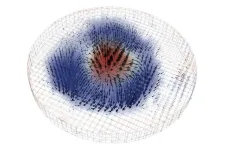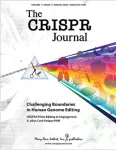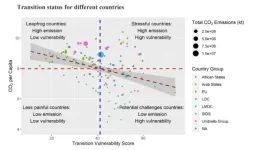(Press-News.org) A difficult-to-describe nanoscale object called the magnetic skyrmion might one day yield new microelectronic devices that can do much more — for example, massive data storage — all while consuming much less power.
But researchers need a more detailed understanding of skyrmions if they are ever to be used reliably in computational devices, including quantum computers. Peter Fischer, a senior researcher at the Department of Energy’s Lawrence Berkeley National Laboratory (Berkeley Lab), led a project to make 3D X-ray images of skyrmions that can characterize or measure the orientations of spins inside the whole object. “Our results provide a foundation for nanoscale metrology for spintronics devices,” Fischer said. The work was recently published in Science Advances.
Magnetic skyrmions can be thought of as spinning circles of magnetism, explains David Raftrey, a student researcher in Fischer’s team who was the lead author of this study. At the center, the magnetic spin is pointing upward, while moving out from the center, the magnetism twists and pulls in a downward direction. What’s more, skyrmions are stable, small, fast, and not easily unfolded, a trait materials scientists dub “topological.”
These spin directions are part of the appeal for skyrmions because they might be used to carry and store information in much the same way that electrons carry and store information in current devices. “However, relying on the charge of the electron, as it is done today, comes with inevitable energy losses. Using spins, the losses will be significantly lower,” Fischer said.
But theoretical knowledge of skyrmions has been based on descriptions of them as 2D objects. In the real world of electronics and silicon wafers — no matter how thin — skyrmions have to be dealt with as 3D objects. To put skyrmions to work, or perhaps to one day synthesize custom skyrmions, researchers must be able to examine and understand their spin characteristics throughout the whole 3D object.
If you are looking at a skyrmion magnetic whirlpool from the top and start slicing off layers, you might think that each successive layer would be the same. “But that’s not the case,” Raftrey said. “And we said, okay, how can we get our arms around this? How do we actually demonstrate this?”
Raftrey took a thin magnetic layer, which was synthesized by colleagues from Western Digital, and patterned a nanodisk using the Molecular Foundry’s nanofabrication facility. To obtain 3D tomographic images he traveled to Switzerland to use a novel imaging technique called magnetic X-ray laminography at a microscopy beamline at the Swiss Light Source.
With X-ray laminography, “You can basically reconfigure and reconstruct [the skyrmion] from these many, many images and data,” Raftrey said. It was a process that took months, finally yielding a better understanding of skyrmion spin structures.
A full understanding of skyrmions’ 3D spin texture “opens opportunities to explore and tailor 3D topological spintronic devices with enhanced functionalities that cannot be achieved in two dimensions,” Fischer said.
The Molecular Foundry is a DOE Office of Science user facility at Berkeley Lab.
The work was supported by the DOE Office of Science.
###
Lawrence Berkeley National Laboratory (Berkeley Lab) is committed to delivering solutions for humankind through research in clean energy, a healthy planet, and discovery science. Founded in 1931 on the belief that the biggest problems are best addressed by teams, Berkeley Lab and its scientists have been recognized with 16 Nobel Prizes. Researchers from around the world rely on the Lab’s world-class scientific facilities for their own pioneering research. Berkeley Lab is a multiprogram national laboratory managed by the University of California for the U.S. Department of Energy’s Office of Science.
DOE’s Office of Science is the single largest supporter of basic research in the physical sciences in the United States, and is working to address some of the most pressing challenges of our time. For more information, please visit energy.gov/science.
END
Magnetic resonance imaging (MRI) can spare many patients with rectal cancer from invasive surgery that can carry lifelong side effects, new research indicates.
The findings, from UVA Cancer Center’s Arun Krishnaraj, MD, MPH, and collaborators, indicate that MRI can predict patient outcomes and the risk of the tumor reccurring or spreading for patients who have undergone chemotherapy and radiation.
That information could be extremely useful in determining the best course of treatment and deciding whether a patient can ...
New Rochelle, NY, October 18, 2024—An invited Guest Editorial entitled “Give Cas a Chance,” by Fyodor Urnov, PhD, Director of Technology & Translation at the Innovative Genomics Institute (IGI), anchors the October 2024 special issue of The CRISPR Journal on “CRISPR Trials.”
As guest editor of the special issue, Dr. Urnov has penned an extraordinary editorial that emphatically defines the magnitude of the crisis in the genome editing arena and offers a path forward. The inherently programmable nature of CRISPR gene editing that makes it ...
WASHINGTON—Adults with type 2 diabetes on a low-carbohydrate diet may see benefits to their beta-cell function allowing them to better manage their disease and possibly discontinue medication, according to new research published in the Endocrine Society’s Journal of Clinical Endocrinology & Metabolism.
Beta-cells are endocrine cells in the pancreas that produce and release insulin, the hormone that controls blood sugar levels.
More than 38 million Americans have diabetes, and over 90% of them have ...
Exposure to higher levels of air pollution as a baby is linked to having a peanut allergy throughout childhood, according to a new study. And policies aimed at tackling poor air quality could potentially reduce the prevalence and persistence of peanut allergies, it stated.
The research, led by Murdoch Children’s Research Institute (MCRI) and the University of Melbourne, found being exposed to higher levels of air pollution from infancy was associated with increased odds of developing a peanut allergy and having the allergy persist across the first 10 years of life. However, the same association was not seen for egg allergy or eczema.
Published ...
The metaverse, a space where the lines between physical and digital realities blur, is rising among younger populations. As of March, 33% of teens own a virtual reality (VR) device and 13% use it weekly.
With the metaverse offering richer emotional experiences, youth may be particularly vulnerable to significant harm in these immersive spaces, underscoring the need to explore potential risks.
Unfortunately, research of online victimization in the metaverse is sorely lacking. A new study by Florida Atlantic University, in collaboration with the University of Wisconsin-Eau Claire, is one of the first to examine the ...
The Energy Transition Vulnerability Index (ETVI) quantifies the vulnerability of nations to adverse impacts of transitioning away from fossil fuels. The COP28 agreement has called for all countries to wind down use of fossil fuels to combat climate change—but the agreement stipulates that these transitions should not disproportionately harm historically marginalized and vulnerable stakeholders. Xunpeng Shi and colleagues create a method of quantifying energy transition vulnerability for 135 countries from 2010 to 2020. The indicator focuses on exposure—which captures the magnitude of the changes required—, ...
Mental fatigue may make rewards more desirable, according to a study in rats and humans. Exerting cognitive effort has been linked with making unhealthy choices. In the past, the link has been explained via a weaking of inhibitory control or will power. Marcello Solinas and colleagues explore the possibility that cognitive effort may also make unhealthy choices more tempting by increasing the perceived reward. Rats who completed a cognitively demanding task self-administered more cocaine than rats who did not complete a cognitive demanding task—or rats who were allowed ...
A significant step forwards in changing research practices towards sustainability has been taken with the publication of the Heidelberg Agreement on Environmental Sustainability in Research Funding. The agreement provides a framework for research funders to play an active role and incentivize sustainable practices in research. It outlines principles for transitioning to a more sustainable research system and practical recommendations on how to implement sustainability in funding schemes.
A key focus of the Heidelberg Agreement is to ensure that research funders take a proactive approach to promoting sustainability in scientific ...
A model of human behavior finds that people will share information if enough—but not too many—of their contacts do so. Humans are social creatures, and many behaviors and beliefs can spread from person to person. Understanding the dynamics of behavioral diffusion can help encourage healthy or sustainable behaviors or stop the spread of misinformation. Linear threshold models assume that people will adopt a behavior when the number of their social contacts that have done so passes a threshold. Pouria Ramazi and colleagues propose an addition to the model, ...
Using plastic sheets for weed control, even under current best management practices, pollutes soil with macro- and micro-plastics and negatively affect critical soil functions, according to a study. The United Nations considers soil plastic contamination an environmental health and food security threat. Around the world, over 25 million acres of farmland is seasonally covered with opaque plastic films used as “mulch” to prevent weeds, retain moisture, and warm soil—a practice known ...







